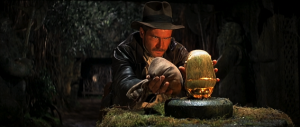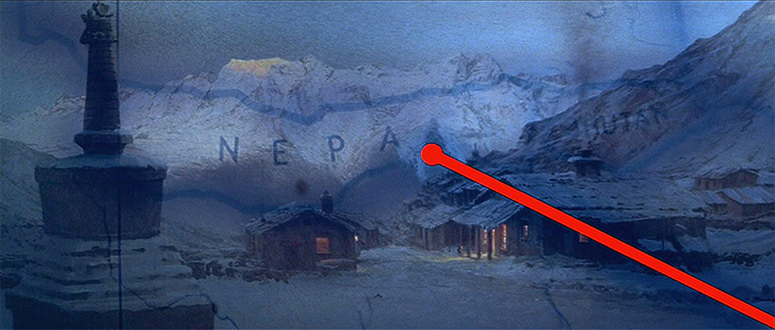I’ve enjoyed a slew of Indiana Jones video games, like The Fate of Atlantis and The Emperor’s Tomb, but I haven’t played the Indiana Jones video game I really want right now. It doesn’t exist. Yet with Uncharted and Tomb Raider paying homage in some ways and setting precedents in others, I think the time is right for a new Indiana Jones video-game adventure.
Here’s what I want an Indiana Jones game to be: an adventure game played in the third-person style of Lara Croft and Nathan Drake with rich exploration of engrossing environments, puzzle-based combat, dialogue scenes that count, and rollicking set pieces. The idea is not to recreate the forward momentum of an Indiana Jones movie, because the movies do that already, but to create a uniquely interactive experience that draws on cinematic techniques and ludic mechanisms in equal measure.
From Uncharted Tombs…
We have lots to learn from the innovations, refinements, and polish of the Uncharted and Tomb Raider games. Set our Indiana Jones game earlier in Indy’s career — in the mid-1920s, perhaps — and I think a skill-point or crafting system like those from Tomb Raider could be put to good use. Maybe Indy has to learn a language, how to repair an engine, or how to reassemble artifacts found shattered at a dig site. Just don’t teach him how to fly a plane.
But the most obvious feature to borrow from the other games, probably, is the ability of those games to build remarkable set pieces that thrill even when they’re largely or wholly linear. A few of those per game are great because those kinds of roller-coasters guarantee an experience for the player even though they channel all choices through bottlenecks. Some of those bottlenecks are damned fun. I sort of don’t care that there’s only one way out of Uncharted 3‘s burning chateau. Finding that way turns out to be a puzzle that’s as quick as it is exciting.
Tomb Raider’s tumbling survival sequences and Uncharted 3’s foot chases are notably interesting to me because they create tense thrills but don’t require the gunning down of villainous mooks by the dozens.
I like a good fight scene plenty, but does the headshot have to be the pinnacle of combat expertise? The brawls in Uncharted 3 feel great to me — I’m always trying to rush bad guys in that game so I can fist-fight them. It’s more entertaining to me because it makes better use of the environment. (You should’ve seen my delight when a London thug got a refrigerator door to the face in that opening pub brawl.) I also like the idea that Indiana Jones, while antiheroically willing to shoot swordsmen intending to kill him, doesn’t have to kill quite so many bad guys to keep our attention. The sound effect of an Indiana Jones punch is plenty satisfying.
Lara’s dodging and dirty fighting in Tomb Raider feels like it could be a great fit for fist-fights like the flying-wing bout in Raiders. Add in environmental effects like giant spinning propellers and you’ve got a great fight scene where the goal is to fight a guy long enough that the propeller can take him out. If Raiders were a video game today, we might have to feed a dozen henchmen into that rotor. Ugh.
Let’s make Indy’s fight scenes into brawling puzzles. Uncharted 3’s London pub fight is a good start, but I want more.
Brawling Puzzles
The goal is to stay up and fighting, steering bad guys into situations throughout the scene that enable Indy to finally put them down. Some thugs might take two or three feats to put down; others might be vulnerable to only one specific threat in the environment, whether it’s the truck he’s driving or that propeller. Triggers for environmental effects reveal themselves through dialogue and objects that glow when you hit LB, maybe.
For example, let’s look at the fight scene in Marion’s bar, the Raven, in Nepal. That’s Indy against just a few thugs. While it might look like a gunfight mixed with a brawl, I think it’s actually an adventurous puzzle sequence. To take out one guy, Indy’s player maneuvers the two of them to the bar and pushes the button to talk to Marion (instead of the button to fight) and thereby gets a bottle of whiskey. Once he gets to the bar, the fire starts to spread thanks to Toht, so Indy has to hit that interaction button and then that fight button quick or he’ll get hurt and have to work harder to survive the rest of the brawl.
Imagine each little victory not as a sure-thing scripted event but as something triggered by moving into a part of the environment. Grapple with that thug near the fireplace? “Shoot them,” Toht says, “shoot them both.” The trick then is to push the thumbstick toward the shooter and pull RT, even though Indy doesn’t have the gun. Or else you spend the rest of the scene dodging gunfire until you can punch that fella out, maybe.
Remember, the fight scenes we see in the films, which inspire the Indy style of action, are examples of one play-through of that environment. The trick, for freedom and replay value, is to have each fight scene feature twice as many environmental actions as are necessary to take out the available bad guys. Maybe Marion shoots the last guy automatically and its up to you to leave one of the toughest thugs for her to shoot at the end, once you know that.
This is fun not only in a puzzle-solving way but in a stage-direction way. It’s about moving the pieces around the board so that they interact in interesting ways with each other and the environmental factors. Replay comes from seeing other environmental factors and watching the combatants interact in different ways.
Dig Sites and the Map
Let’s dig deeper into Indiana Jones’s game environments and offer up a degree of freedom to explore Indy’s world that Indiana Jones comics and movies can’t provide. Let’s use the exploration hubs and action sequences of Tomb Raider to let Indy explore a dig site before triggering the arrival of Forrestal’s goons (or whoever). Let’s add in relics and treasures that need to be inspected a bit before they give up all their secrets. Let’s hear Indiana Jones tell us why this knight’s shield or catacomb inscription is significant.
While the race-to-the-artifact stories that Indy is best known for are often chases, this Indiana Jones game adventure isn’t paced quite the same way. Three different dig sites at three different locales can be explored (and have action sequences triggered within them), allowing players to control a bit of their pacing. Do they want to explore each location first and then trigger one action sequence after another? That’s a legitimate way to play. Do they want to explore each location in turn, activating action sequences as they’re suggested? That’s also great.
To do this, we give the player control over the Map, taking Indy from location to location as necessary to solve certain puzzles or challenges. (In the original drafts of Raiders, the medallion is in two parts and Indy has to go get them; those locales could be done in any order.) Once you find the knight’s tomb beneath Venice, you can explore it. Once you get the paper rubbing off his shield (necessary later in the game), you trigger a deathtrap action sequence followed by the boat chase. Then you can move on from Venice or keep looking around for documents of Henry Jones, Sr., or relics left behind.
This borrows a lot from the fast-travel camps, documents, and relics of Tomb Raider, of course. I think there’s a lot of good play to be had from placing Map locations worldwide and then making the gatekeeping around each departure be based on artifacts, on communication, on puzzle-solving, and XP for Dr. Jones, in addition to jumping and shooting. Giving the player multiple destinations from each hub can be a design headache, I know, but also presents fun choices for the player in control of the Map.
Professor, Adventurer
The video games where I tend to most enjoy playing characters are those with compelling characters already at their core: Tomb Raider‘s Lara Croft, Thief’s Garrett, Uncharted’s Nathan Drake. That doesn’t mean we can’t learn a bit from the RPG elements of games like the Mass Effects, too. So let’s.
I like playing a part — a specific part — as much as I like drifting my take on a character this way or that. My Nathan Drake is less lethal than some, brawling whenever he can. My Lara Croft might be stealthier than yours.
Let’s have dialogue scenes that count for something. This is a chance to not just move and fight like Indiana Jones but to talk and think like him, playing out scenes that add detail and color to the larger adventure. Think of Uncharted’s cutscenes and Mass Effect’s dialogue scenes blended together. You wouldn’t deeply change the nature and style of Indiana Jones the way you might change Commander Shephard, but you could impact the gameplay by changing the context or subtext of scenes even as you change their, you know, actual text. Maybe the Thuggee send more men to assassinate Indy and Short Round in the night if Indy chooses not to apologize at dinner in Temple of Doom, for example.
The dynamic of conversations that count in gameplay is something I want to write more about, but it goes beyond this game. So tune in tomorrow for that post.



